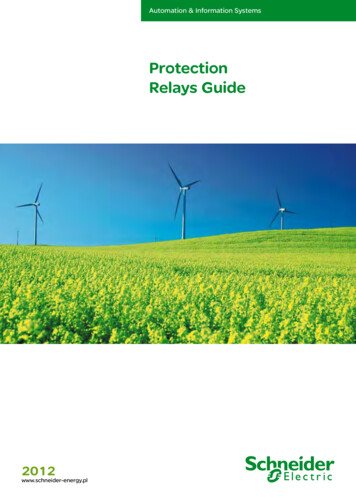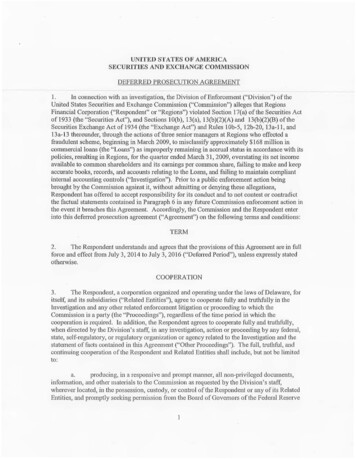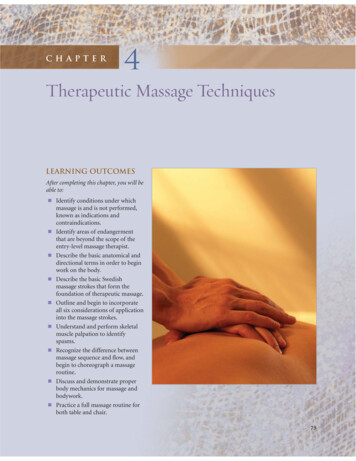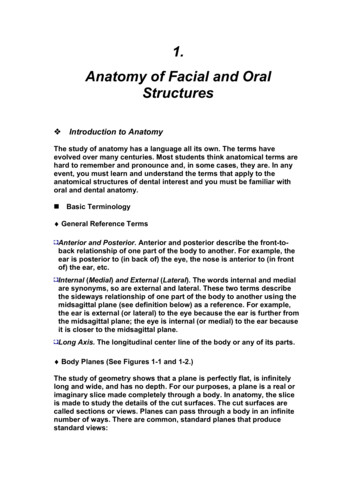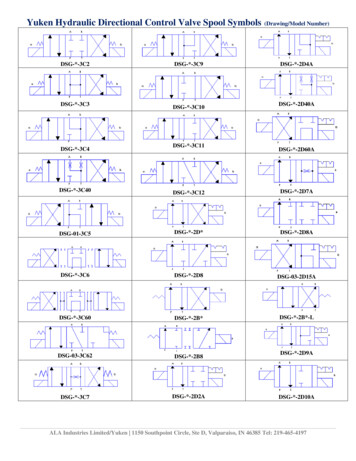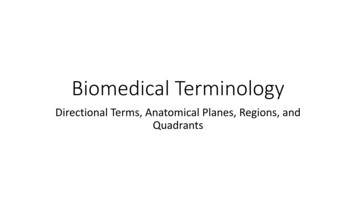
Transcription
Biomedical TerminologyDirectional Terms, Anatomical Planes, Regions, andQuadrants
Anatomic Position and Directional CombiningForms All directional terminology is basedon anatomic position A reference position - standing witharms to the side and palms facingforward and feet placed side by side Note: -ior, al – pertaining to, -ad toward Combining Forms of DirectionalTerms Anter/o – frontCaud/o – tail (downward)Cephal/o- head (upward)Dist/o – away (from the point ofattachment of a body part) Combining Forms of DirectionalTerms (cont.) Dors/o – backInfer/o – belowLater/o – sideMedi/o – middlePoster/o – back, behindProxim/o – near (the point ofattachment of a body part) Super/o – above Ventr/o – belly (front)
Directional Terms Anterior (ant) Pertaining to the front Posterior Pertaining to the back Ventral Pertaining to the belly (front) Dorsal Pertaining to the back Note: dorsal and ventral are often usedwhen discussing structures Anterioposterior (AP) Pertaining to the front and to the back Posterioanterior (PA) Pertaining to the back and the front
Directional Terms Superior (sup) Pertaining to above Inferior (inf) Pertaining to below Cranial Pertaining to the head Cephalic Pertaining to the head Caudad Toward the tail (downward) Caudal Pertaining to the tail (downward)
Directional Terms Medial (med) Pertaining to the middle Lateral (lat) Pertaining to the side Unilateral Pertaining to one side Bilateral Pertaining to two sides Contralateral Pertaining to the opposite side Ipsilateral Pertaining to the same side
Directional Terms Superficial At, near, or relatively close to thebody surface Deep Farther from the body surface
Directional Terms Some directional terms arebased on the relationship to theaxial and appendicular skeleton Axial and Appendicular Skeleton Axial Skeleton includes The skull (cranial and facial bones)Bones associated with the craniumThe vertebral columnThe thoracic cage Appendicular Skeleton includes Girdles (pectoral and pelvic) Extremities (upper and lower)
Directional Terms Proximal Pertaining to near (to the point ofattachment of a body part Distal Pertaining to away (from the pointof attachment of a body part)
Anatomic Planes Frontal or Coronal A plane that separates the body orstructure into anterior and posteriorsections Sagittal A plane separating the body or a structureinto left and right sections A midsagittal plane seperates into equal leftand right halves Transverse or Horizontal A plane that separates the body orstructure into superior and inferior sections Oblique A plane that separates the body orstructure and is not one of those listedabove
Abdominopelvic RegionsDivisions of the abdominopelvic cavity into 9 artificial divisionfor note taking and communication Umbilical region Around the navel (umbilicus) Epigastric region Directly above the umbilical region Hypogastric region Directly below the umbilical region Hypochondriac region To the right and left of the epigastric region Lumbar region To the right and left of the umbilical region Iliac region To the right and left of the hypogastricregion
Abdominopelvic QuadrantsDivisions of the abdominopelvic cavity into 4 artificial divisionfor note taking and communication Right upper quadrant (RUQ) Refers to the area encompassingthe right lobe of the liver*, thegallbladder*, part of the pancreas,portions of the small and largeintestines, the right kidney Left upper quadrant (LUQ) Refers to the area encompassingthe left lobe of the liver, thestomach, the spleen, part of thepancreas, portions of the smalland large intestines, the leftkidney
Abdominopelvic QuadrantsDivisions of the abdominopelvic cavity into 4 artificial divisionfor note taking and communication Right lower quadrant (RLQ) Refers to the area encompassingportions of the small and largeintestines, the appendix*, the rightureter, and the right ovary anduterine tube in women and rightspermatic duct in men Left lower quadrant (LLQ) Refers to the area encompassingportions of the small and largeintestines*, the left ureter, and theleft ovary and uterine tube in womenand the left spermatic duct in men
Visceral Pain Patterns * On the previous slides, these arekey structures that may indicatepathology with pain in a particularquadrant. While pain in a particular quadrantis should be considered, it isimportant to know that visceralpathology can refer pain to areasaway from their location. Note: These referral zones are notpart of this class.
Terms specific for various body regions – Not on Test
Pertaining to the back Ventral Pertaining to the belly (front) Dorsal Pertaining to the back Note: dorsal and ventral are often used when discussing structures Anterioposterior (AP) Pertaining to the front and to the

